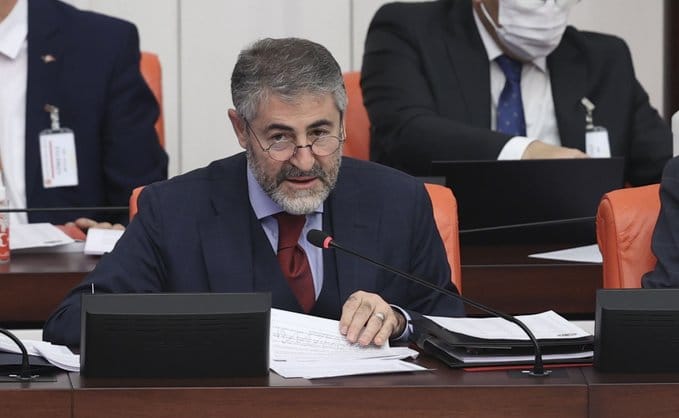

Turkish Ministry of Treasury and Finance Minister Nureddin Nebati detailed the fiscal moves announced by President Tayyip Erdoğan on December 20, which aimed to take recent fluctuations of the Turkish Lira under control with a new system.
The positive side of the new system is as follows: The announced decisions have prevented the out-of-control increases in exchange rates. This alone is a significant and positive feature. Yet, it is essential to focus on the new system’s risks and reduce these risks. In order to identify these problems, it is necessary to consider how the recently taken decisions can affect various sectors.
The new system for the saver
I. If the exchange rate rise is higher than the deposit interest at the end of the maturity date, the depositor will earn a return equal to the exchange rate upsurge.
II. If the exchange rate increase at the end of maturity is lower than the deposit interest, the depositor’s return will equal the deposit interest.
The first alternative of the saver
The first alternative is to hold foreign currency or open a foreign currency deposit account. Foreign currency deposit interest rates are too low. Therefore, there is no difference between having foreign currency and holding foreign currency deposits. Let me call both “keeping foreign currency.” In this case:
I. If the exchange rate rise at maturity is higher than the deposit interest rate, there is no difference between holding foreign currency and entering the new system.
II. If the exchange rate upsurge at the end of maturity is lower than the deposit interest rates, she loses when she does not enter the new system and keeps foreign currency.
The second alternative of the saver
The second alternative is to hold the Treasury’s foreign currency indexed bonds. The same analysis as in the first alternative is valid. Hence, here is a result for the Treasury: If the Treasury is to sell bonds to the saver, it is not ample that the bonds to be issued are indexed to the exchange rate or denominated in foreign currency. As long as the exchange rate increases stay below the deposit rate, the saver loses. For this reason, the Treasury needs to issue a bond that provides parallel returns to the new system. (A bond yields as much as the exchange rate rises or the deposit interest rate, whichever is higher).
Effect of inflation on savings decision?
Note that inflation is not taken into account in the above analysis. Let us suppose a situation like this: Expected inflation is greater than the expected exchange rate increase or the deposit rate, whichever is higher. In this case, the value of my savings will eventually erode.
Why should I enroll in the new system? Or why should I hold foreign currency? What are my alternatives? I can join the stock market, or I can minimize my savings. In other words, I can increase my consumption. Forget the stock market. In addition, this will be a condition that will increase inflation and the current account deficit. If inflation rises, it will be harder for the new system to work. As discussed below, if the current account deficit increases, the risk perception may improve, which is a danger for the new system.
The result for the saver
She will enter the system if she trusts and believes that inflation will not be higher than the exchange rate upsurge (or deposit interest rate, whichever is greater).
One question arises: The new system has 3, 6, 9, and 12-month maturities, whereas most deposits have 32-33 days. These are not covered. Do they need to be covered?
Thus, it is vital to build trust in the system and lower inflation expectations.
In terms of banks
Bankers have welcomed the new system with enthusiasm, so to speak, since they will be able to provide resources and available loans with a low deposit interest rate (policy interest or a little more). However, it is theoretically possible to think like this: Suppose you are the shareholder of a private bank. You are to increase the capital at your bank. Under normal circumstances (disregarding other costs), you want a rate of return to cover the cost of the resources you collect (let us say the interest on the deposit) and a reasonable rate of return.
Nevertheless, here is a situation: If you deposit at a competitor bank instead of increasing the capital of your bank, you have a chance to earn more in the new system. Under what conditions? If your expected exchange rate increase is high.
This view may seem eccentric to most readers; yet, it is standard for economists accustomed to calculating “opportunity costs.” This approach implies a lower limit at which the loan rate (from the equity perspective) can fall. Its significance for the new system is as follows: It is crucial not to create an environment where the exchange rate is anticipated to rise significantly.
In terms of the Treasury
There are some points yet to be clarified. On December 21, the CBRT published a new communiqué applicable for those who convert their foreign currency deposits into the lira. If the exchange rate increase is above the deposit rate, the difference is covered by the CBRT. The same clarity does not exist for deposits in the lira. In the Treasury statement, it is said that it is “covered.” It is not yet clear which authority will be responsible for covering it. I continue the analysis assuming that the Treasury will be responsible for this difference.
In this case, firstly, as long as the actual exchange rate increase is above the deposit rate, the state budget will be adversely affected. Secondly, suppose this burden on the budget is to be financed by borrowing. In that case, the Treasury’s debt will increase, and the borrowing maturity will shorten in terms of risk accounts.
The result for the Treasury is as follows: There should not be a significant difference between the exchange rate increase and the deposit interest rate, nor widen the difference. That can be achieved by either not increasing the exchange rate too much or increasing the deposit interest rate. Nevertheless, it is not desired to raise the deposit interest rate, so the exchange rate should not escalate considerably.
In terms of foreign debt rollover
Let us assume we will not have a current account deficit next year. Let us even give some current account surplus: 10 billion dollars. Our due foreign debt payment is 170 billion dollars. If you deduct 10 billion dollars, the remaining 160 billion dollars must be financed. An essential part of this is commercial credit: Consider no financing problem. If there is a rollover problem on some of the remainder of the debt, upward pressure on the exchange rate will occur. Conversely, I stated above that the exchange rate should not rise significantly for the Treasury; and the banks to a certain extent.
The question is: under what conditions can we have a problem rolling over the debt? Apparently, what if our risk escalates (or does not go down from its current high). Then, another conclusion is this: Our risk needs to lessen, or at least not rise.
External factors
Another question: What could be the factors that negatively affect our risk?
External factors may adversely affect our risk. For example, the U.S. Federal Reserve may be aggressive with raising interest rates. Let us exclude such external factors from the analysis. In this case, within the framework of the above analysis, the factor that will negatively affect our risk is an escalation in the Treasury’s burden. Attention: If the burden on the Treasury increases, the risk increases, the foreign resource inflow decreases, the exchange rate increases, the burden on the treasury increases, the risk increases…
It is indispensable to minimize the possibility of the formation of this spiral.
The moral of this article
1. Trust in the system. 2. Lessening expectations of inflation. 3. Diminishing risk perception. 4. Smooth resource inflow from abroad.
Last but not least, what was the need for all this new system? We could have avoided the hikes in exchange rates, and most strikingly, we could have reduced inflation.


